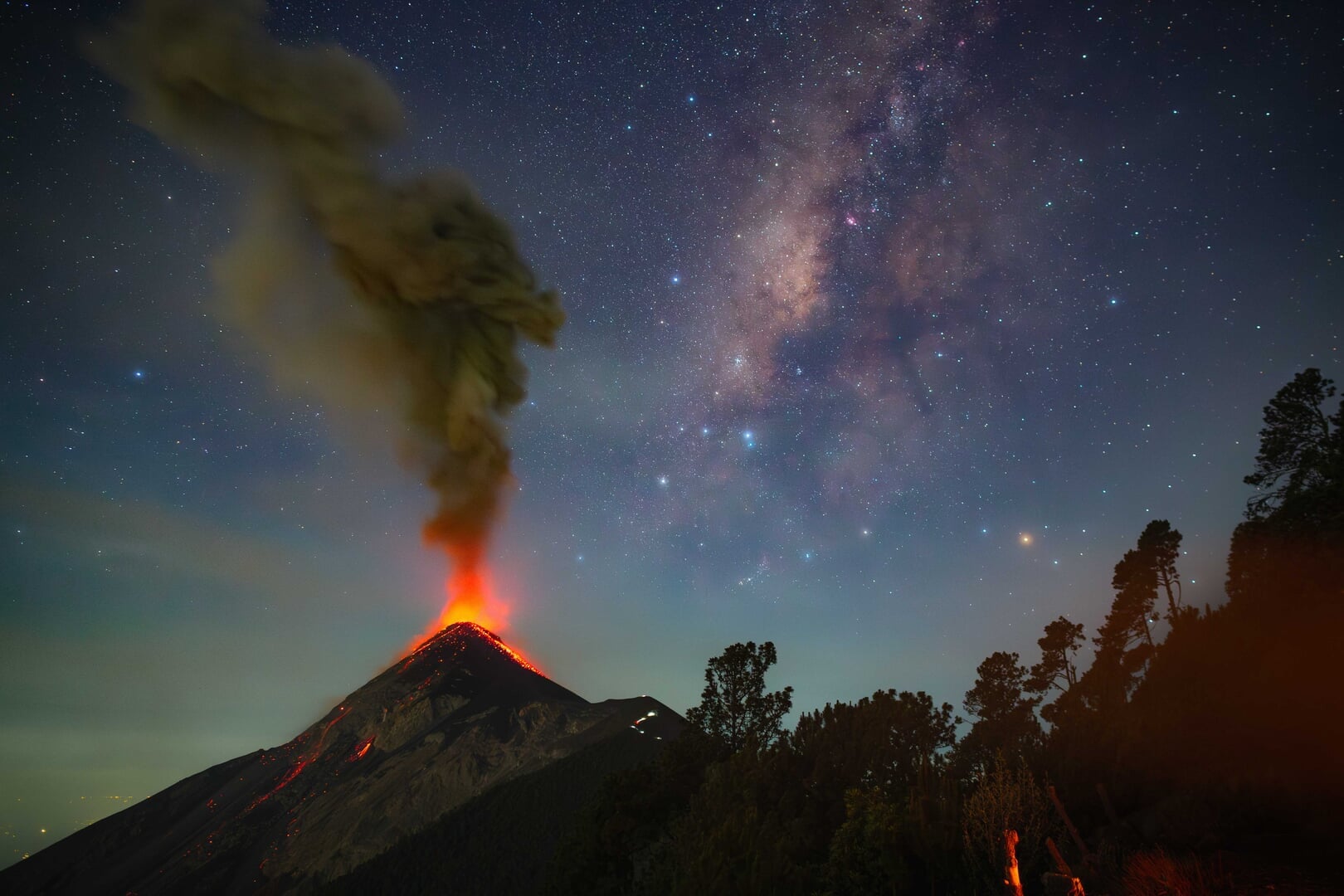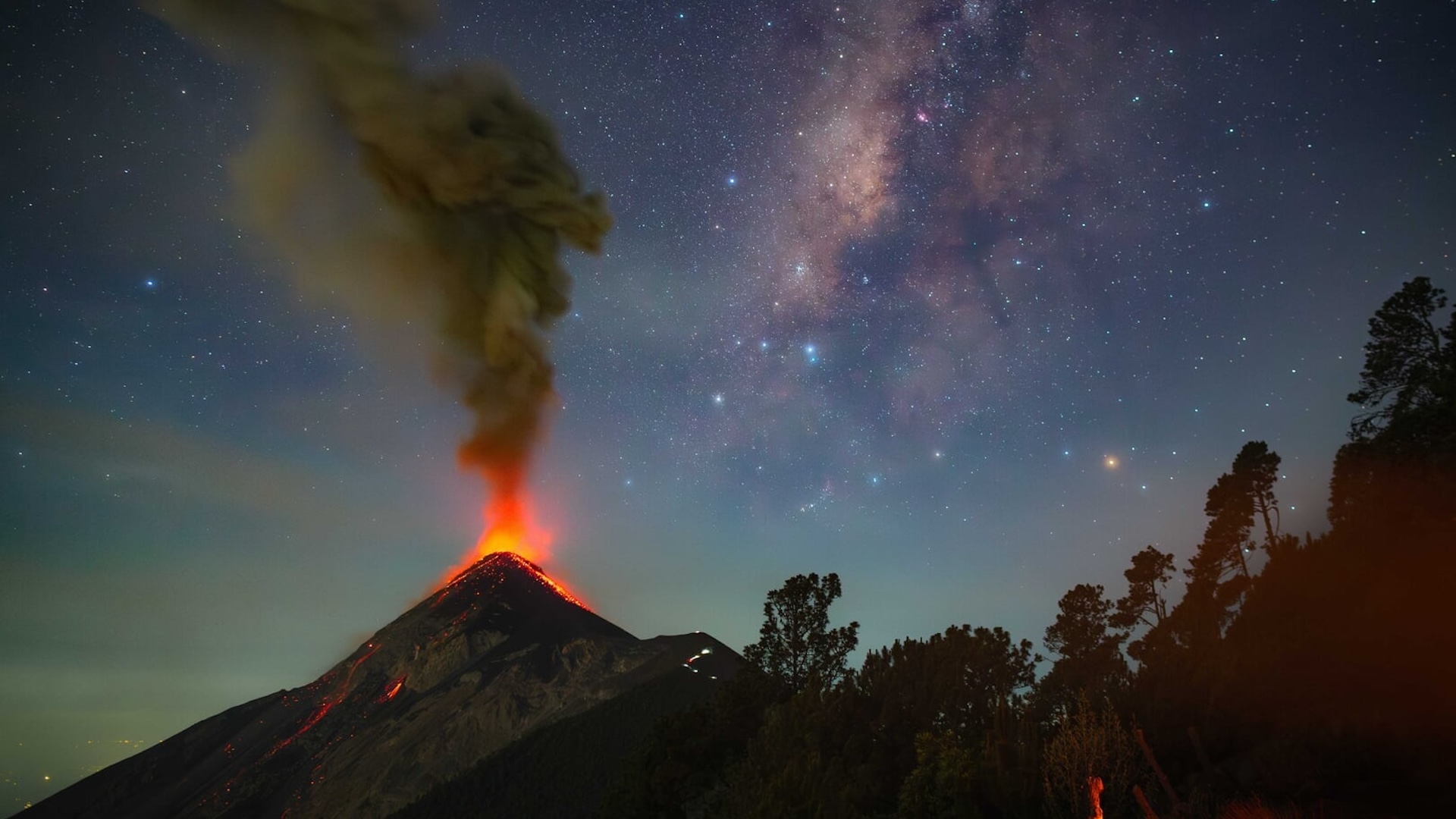The honorees for the 2025 Milky Way Photographer of the Year contest are in, and they’re stunning.
Created in 2018 by photographer Dan Zafra, the contest showcases shots of the Milky Way taken from around the globe, highlighting gorgeous landscapes on Earth laid out under the twinkling night sky. This year’s winners include shots from places as diverse as Namibia, the Himalayas, New Zealand and Yemen. There’s even a photo taken from space.
“Starlit Ocean”
Photographer: Xingyang Cai
Location: Big Sur, California
This photograph, titled “Starlit Ocean: A Comet, the setting Venus, the Milky Way, and McWay Falls,” was taken during the approach of Comet Tsuchinshan-ATLAS (C/2023 A3) in fall 2024. The comet streaks above the Pacific and a setting Venus at McWay Falls in Big Sur.
“Cosmic Fire”

Photographer: Sergio Montúfar
Location: Acatenango volcano, Guatemala
Photographer Sergio Montúfar captured this stunning image of two types of fire in the sky at Acatenango volcano in Guatemala in June 2024. “Above, the Milky Way stretched diagonally across the sky, a mesmerizing band of stars contrasting with the chaos below,” Montúfar wrote in his description of the photograph. “As the volcano erupted, the ash plume rose vertically, forming an acute angle of about 45 degrees with the galaxy’s diagonal path, creating a stunning visual contrast between Earth’s fury and the cosmos’ serenity.”
Montúfar used a wide-angle lens (f/2.8), an ISO of 3200, and a 10-second exposure to capture the light of the Milky Way and the light of the volcano at the same time.
“Blossom”
Photographer: Ethan Su
Location: Hehuan Mountain Dark Sky Park, Taiwan
An explosion of alpine rhododendrons provides a stunning foreground to this view of the Milky Way from Mount Hehuan in central Taiwan. A solar flare from the sunspot AR3664 added a slight airglow to the scene, while clouds blocked light pollution from distant urban areas.
“One in a Billion”
Photographer: Don Pettit
Location: Earth orbit
Astronaut Don Pettit captured this image of Earth against the Milky Way from the Cupola of the International Space Station. City lights seem to mirror the jewel-like glow of the galaxy in the background of the image. “There are over eight billion people that call this planet home,” Pettit wrote. “There are seven of us that can say the same for [the] Space Station. What a privilege it is to be here.”
Related: May’s best stargazing week has begun. How to see a lion, an upside-down bear, a mini ‘planet parade’ — and more.
“Bottle Tree Paradise”
Photographer: Benjamin Barakat
Location: Socotra, Yemen
Four years of scouting Socotra, a Yemeni island in the Indian Ocean, led photographer Benjamin Barakat to this grove of bottle trees (Dendrosicyos socotranus), a species that’s unique to the island. These trees’ thick trunks allow them to store water to survive Socotra’s dry climate. The Milky Way decorates this one-in-a-galaxy site like a bangle of jewels.
“Lake RT5”
Photographer: Tanay Das
Location: Zanskar, Himalayas
Celestial fire and Earthly ice meet in this shot taken at Lake RT5, which sits 18,700 feet (5,700 meters) high in the Himalayas. Photographer Tanay Das camped by this lake to capture this shot of the Milky Way. “I was in awe of the incredible airglow illuminating the Himalayan skies,” Das wrote. “The raw image had even more intense colors, but I toned them down to stay true to reality. This was undoubtedly one of the most unforgettable nights I’ve ever spent in the heart of the Himalayas.”
“A Sea of Lupines”
Photographer: Max Inwood
Location: Lake Tekapo, New Zealand
Lupines bloom on New Zealand’s South Island in a purple feast for the eyes. The dark skies of New Zealand’s Mackenzie Basin — along with a lot of patience — enabled this shot.
“I had to wait until the early hours of the morning for the wind to calm down, but eventually everything became still, and I was able to capture this image,” photographer Max Inwood wrote. “Above the flowers, you can see the band of the outer Milky Way, alongside the constellations Orion, Gemini, and the Pleiades. Joining them are the bright planets Jupiter and Mars, with a strong display of green airglow visible along the horizon.”
“Spines and Starlight”
Photographer: Burak Esenbey
Location: Karas region, Namibia
The Milky Way slashes across the sky behind cacti and two quiver trees (Aloidendron dichotomum) in Namibia. This was photographer Burak Esenbey’s second photography trip to the area, and he found this spot on a location-scouting excursion. “Getting everything in focus was a bit challenging, as I had to get extremely close to the cactus without getting poked,” he wrote in his description of the image.
“Boot Arch Perseids”
Photographer: Mike Abramyan
Location: Alabama Hills, California
Photographer Mike Abramyan wanted to photograph the Perseid meteor shower from the Canadian Rockies, but wildfires drove him westward and southward to California’s Eastern Sierra, where he captured this stunning image of the Milky Way superimposed with each meteor he photographed — as if they’d all streaked across the sky at the same time.
“Universo de Sal”
Photographer: Alejandra Heis
Location: Jujuy, Argentina
Photographer Alejandra Heis took this photograph while traveling across Argentina’s iconic locations. The salt flats of Salinas Grandes in northern Argentina begged for a nighttime photoshoot, despite the challenges of camping on desiccated salt flats at an elevation of nearly 17,000 feet (5,200 m). “I believe I haven’t truly experienced a place until I see it at night,” Heis wrote. “Nighttime feels more intimate, mysterious, and adventurous — a moment when the senses sharpen and you connect with your surroundings in a deeper way.”
